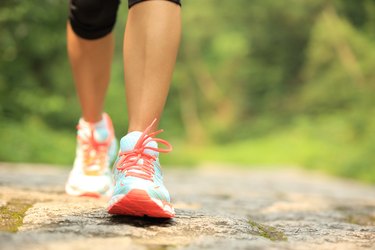
You probably don't think about your stride too much, but most people use a heel to toe walking technique. That's because it is much more efficient than the toe to heel walking used by many animals. Learning about ball walking vs. heel walking will help you decide which technique to use.
Heel to Toe Walking
Video of the Day
Almost everyone has a heel to toe walking stride. While that technique can cause heel pain, it also has many advantages. The writers of a May 2012 paper in Interface showed the humans have developed this stride because it's both mechanically economical and physiologically economical. The authors suggest that human ancestors may have walked this way for millions of years.
Video of the Day
The opposite technique, a toe to heel pattern, is often considered a pathology. Yet little evidence supports this idea, according to a 2012 review in the Iowa Orthopaedic Journal. Toe walking seems only a cosmetic problem. Doctors will only correct the toe-heel pattern when it causes distress. If you need treatment, successful options include both behavioral and surgical approaches.
Still, the writers of an April 2015 report in the Journal of Child Neurology found a relationship between toe walking and autism in 61 children. If your child consistently shows the toe-heel pattern, please speak with a health care professional and ask for a thorough examination.
The authors of a December 2012 article in the Journal of Pediatric Orthopedics tested 51 children and found that kids with a toe-heel stride had more neuropsychiatric problems than age-matched controls.
Read more: Can Walking Be Enough to Reduce Obesity?
Walking Stride Economy
The current stride of modern humans gives them an advantage. The writers of a March 2014 paper in Medicine and Science in Sports and Exercise tested 20 healthy athletes and showed that heel strikers have better running economy than ball strikers.
Gender doesn't seem to affect these results as both women and men heel strikers have better running economy. Interestingly, the better economy found in this study didn't lead to better performance. It only decreased the effort needed to reach the goal.
Researchers have reached a similar conclusion with walking. The authors of a July 2013 report in the Journal of Experimental Biology combined data from mathematical models and human tests to show that you gain more force and waste less energy with heel to toe walking.
The toe-heel pattern expends greater energy because it puts undue stress on the extensor muscles of the ankle, knee and hip. This finding suggests that the heel-toe pattern is the correct way to walk on your feet when you want to protect your muscles.
Read more: Muscles Used in Hip Extension
Barefoot Walking and Running
Barefoot walking and running have become increasingly popular. You can safely work out barefoot in some cases, but you should consult with a health care expert before doing so. The writers of an April 2012 paper in Exercise and Sport Sciences Reviews stated that barefoot runners often generate impact forces of 1.5 to 2.5 times their body weight.
To manage these large forces, barefoot runners typically adopt a toe to heel pattern to decrease the impact which eventually reaches their heel.
People who wear running shoes don't make this adjustment. The study in Exercise and Sport Sciences Reviews showed that the raised, elastic heel of running shoes decreases the heel impact by 10 percent. This smaller impact feels better, yet these shocks still penetrate your body.
This damage might eventually break down your soft tissues. The toe-heel pattern has the potential to cause less long-term damage. Thus, it might be the correct way to walk on your feet when you want to protect your joints.
- Interface: "Human Foot and Heel–Sole–Toe Walking Strategy"
- Iowa Orthopaedic Journal: "Idiopathic Toe Walking"
- Journal of Child Neurology: "Toe Walking in Autism"
- Journal of Pediatric Orthopedics: "Neuropsychiatric Symptoms and Problems Among Children With Idiopathic Toe-Walking"
- Medicine and Science in Sports and Exercise: "Rearfoot Striking Runners Are More Economical Than Midfoot Strikers"
- Journal of Experimental Biology: "Mechanical and Energetic Consequences of Rolling Foot Shape in Human Walking"
- Exercise and Sport Sciences Reviews: "What We Can Learn About Running From Barefoot Running"